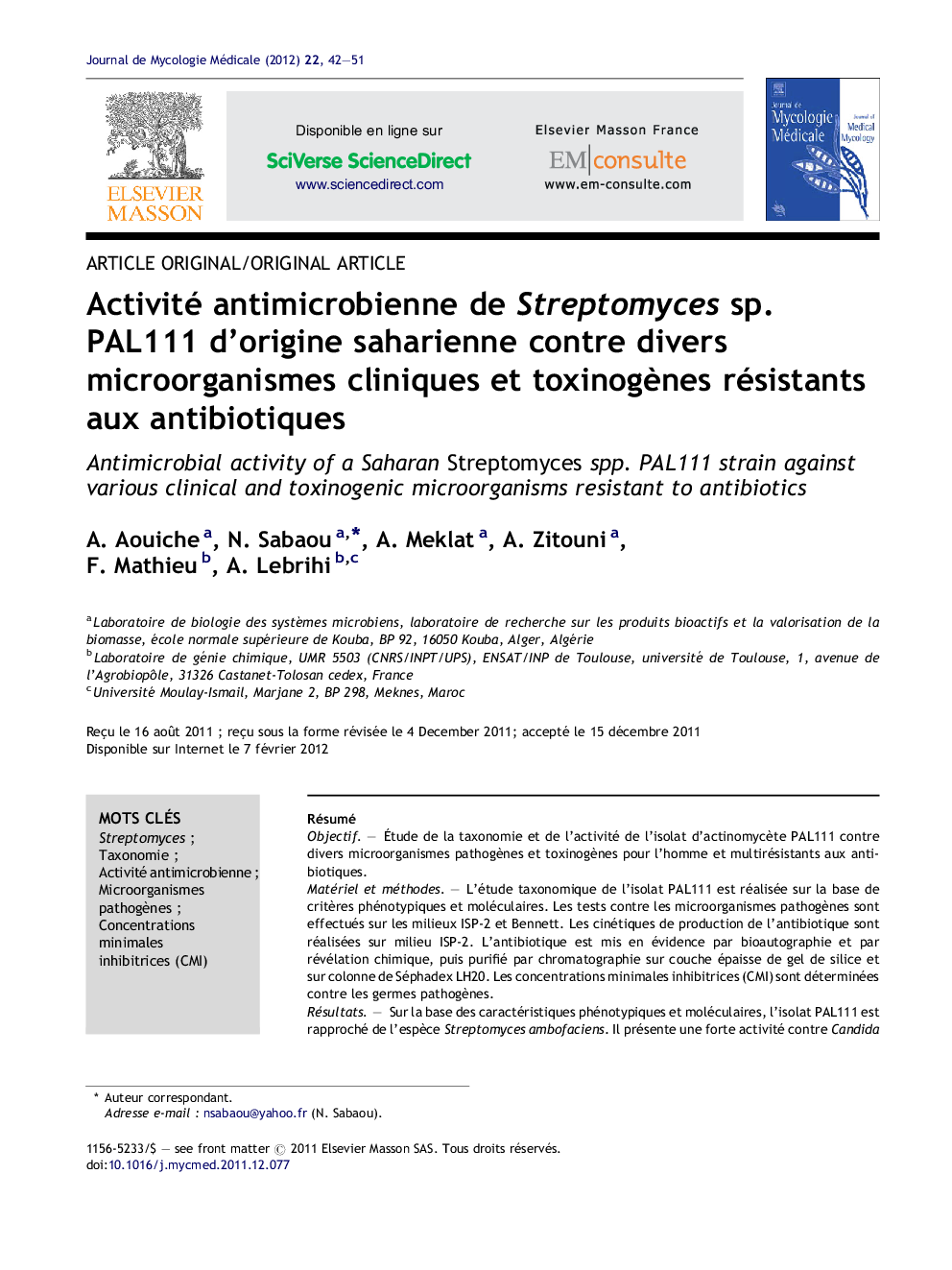| کد مقاله | کد نشریه | سال انتشار | مقاله انگلیسی | نسخه تمام متن |
|---|---|---|---|---|
| 3219666 | 1204452 | 2012 | 10 صفحه PDF | دانلود رایگان |

RésuméObjectifÉtude de la taxonomie et de l’activité de l’isolat d’actinomycète PAL111 contre divers microorganismes pathogènes et toxinogènes pour l’homme et multirésistants aux antibiotiques.Matériel et méthodesL’étude taxonomique de l’isolat PAL111 est réalisée sur la base de critères phénotypiques et moléculaires. Les tests contre les microorganismes pathogènes sont effectués sur les milieux ISP-2 et Bennett. Les cinétiques de production de l’antibiotique sont réalisées sur milieu ISP-2. L’antibiotique est mis en évidence par bioautographie et par révélation chimique, puis purifié par chromatographie sur couche épaisse de gel de silice et sur colonne de Séphadex LH20. Les concentrations minimales inhibitrices (CMI) sont déterminées contre les germes pathogènes.RésultatsSur la base des caractéristiques phénotypiques et moléculaires, l’isolat PAL111 est rapproché de l’espèce Streptomyces ambofaciens. Il présente une forte activité contre Candida albicans, les champignons filamenteux et les bactéries à Gram positif et à Gram négatif. L’activité optimale est obtenue en fin de phase exponentielle de croissance et début de phase de déclin. Les bioautographies ont montré la présence d’un antibiotique à activité antibactérienne et antifongique. Cet antibiotique est hydrophile et de nature osidique et aminé. Les CMI obtenues se situent entre 2 et 20 μg/mL pour les levures, 10 et 50 μg/mL pour les champignons filamenteux, 2 et 10 μg/mL pour les bactéries à Gram positif et 20 et 75 μg/mL pour les bactéries à Gram négatif.ConclusionL’activité intéressante de PAL111 contre les germes pathogènes et la nature hydrophile de l’antibiotique qu’il sécrète incite à la poursuite des études sur cette molécule bioactive.
SummaryObjectiveStudy of the taxonomy and the biological activity of the actinomycete strain PAL111 against several pathogenic and toxigenic microorganisms for humans, and resistant to many antibiotics.Materials and methodsThe taxonomic study of isolate PAL111 is carried out on the basis of phenotypic and molecular characteristics. The tests against the pathogenic microorganisms are realized on ISP-2 and Bennett media. The kinetics of antibiotic production was investigated on ISP-2 medium. The antibiotic is highlighted by bioautography and chemical revelations, and then purified by chromatography on thick layer of silica gel and Sephadex LH20 column. The minimum inhibitory concentrations (MIC) were determined against pathogenic microorganisms.ResultsThe phenotypic and molecular studies showed that the isolate PAL111 is closely related to the type strain of Streptomyces ambofaciens. It showed a strong activity against Candida albicans, filamentous fungi, and Gram-positive and Gram-negative bacteria. The optimal antibiotic production was observed at the end of the exponential phase of growth and at the beginning of the decline phase. The bioautography tests showed the presence of an antibiotic with both antibacterial and antifungal activities. This antibiotic is a hydrophilic amino-glycoside compound. The MIC were observed between 2 and 20 μg/mL for yeasts, 10 and 50 μg/mL for filamentous fungi, 2 and 10 μg/mL for Gram-positive bacteria, and 20 and 75 μg/mL for Gram-negative bacteria.ConclusionThe strong activity of isolate PAL111 against the pathogenic microorganisms and the polar characteristic of the produced antibiotic could encourage further studies on this bioactive molecule.
Journal: Journal de Mycologie Médicale / Journal of Medical Mycology - Volume 22, Issue 1, March 2012, Pages 42–51